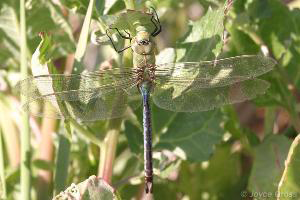Male common green garners patrol shorelines competing with other males in search of females for mating. Because males must select a territory that is attractive to females and defend it from other would-be mates, males often hold races over ponds and duel in spectacular aerial battles for the rights to mate with the female darners in that territory.
Photo Credit: Joyce Gross
Anax junius
Common Name: common green darner
Animal Guild: Insect
Class > Order > Family: Insecta > Odonata > Aeshnidae
What does the species look like?
Both sexes: Wings in both sexes are clear but have yellow leading edges and are often tinted with amber, especially in females. Immatures are reddish on the abdomen and can be confused with the comet darner (Anax longipes ), but are smaller, duller, and have the bull's-eye pattern on their forehead.
Males: The thorax is bright green without distinctive markings and may have brown lightly represented on the lateral sutures. The male abdomen is blue (becoming purple when cool), is brightest at the base, and has a dark dorsal stripe that broadens at one end. The face is pale green, and the eyes are green to dull, greenish-yellow to brown. The species exhibits a blue semicircle bulls-eye pattern on the frons (forehead) region.
Females: The thorax is green, often grayish-green on the sides; the abdomen rusty brown to purple, with dark dorsal stripes. The eyes are brown.
Total length: 68-84 mm; abdomen: 46-60 mm; hindwing: 45-58 mm.
Similar species: In northeastern North America, this is one of only two darners with an entirely green thorax. In the south-central U.S., the Amazon darner (Anax amazili ) has a triangular spot on the top of the forehead, and the abdomen appears ringed. The giant darner (Anax walsinghami ) is much larger, while the great pondhawk (Erythemis vesiculosa) is much smaller. The female common green darner somewhat resembles both sexes of the comet darner (Anax longipes ), but is much duller red on the abdomen than the male, not as spotted on the abdomen as the female, and is smaller overall. The comet darner also does not have the bull’s eye mark on its forehead."
Where is the species found?
States & Provinces
AB, AK, AL, AR, AZ, BC, CA, CO, CT, DE, FL, GA, HI, IA, ID, IL, IN, KS, KY, LA, MA, MB, MD, ME, MI, MN, MO, MS, MT, NB, NC, ND, NE, NH, NJ, NM, NS, NV, NY, OH, OK, ON, OR, PA, PE, QC, RI, SC, SD, SK, TN, TX, UT, VA, VT, WA, WI, WV, WY
Distribution
Common green darners are widespread throughout North America. They are found in every state and in southern Canada. They are also found in the West Indies, Guatemala and Belize, and to the south, in Costa Rica. Recently, they have even been found in England.
This species lives in a wide variety of wetlands, including well-vegetated permanent and temporary ponds and lakes. They also occur in slow-flowing streams with emergent vegetation. Males patrol shorelines, clashing with other males in the search for females. It is one of just three darner species that perches in low grasses and weeds.
General Phenology and Life History
Common green darners usually mate during a short time in the summer. Adults live for only a few weeks and fly from early morning until dusk, often joining late afternoon feeding swarms. Green darners are also one of the few species that migrates during spring and fall.
Flight period: Year-round in the South; early August to mid-October in the North; April to November in California; May to October in Washington; May to September in British Columbia; March or April to October in the central states, sometimes with a lull in mid-summer; and April to November in the northeast.
Which phenophases should I observe?
Do you see/hear...?
Activity
Adults More...
For abundance, enter the number of individual animals observed in this phenophase.
Adults feeding Anax junius , adults feed on almost any flying insect they can catch.
For abundance, enter the number of individual animals observed in this phenophase.
Migrating adults More...
For abundance, enter the number of individual animals observed in this phenophase.
Reproduction
Mating For abundance, enter the number of individual animals observed in this phenophase.
Egg laying Anax junius , females often lay eggs while still being grasped by their mate.
For abundance, enter the number of individual animals observed in this phenophase.
Development
Recently emerged adults Anax junius , recently emerged adults have a reddish-purple abdomen.
For abundance, enter the number of individual animals observed in this phenophase.
Dead adults For abundance, enter the number of individual animals observed in this phenophase.
Method
Individuals at a light For abundance, enter the number of individual animals observed in this phenophase.
Individuals in a net For abundance, enter the number of individual animals observed in this phenophase.
Individuals in a trap For abundance, enter the number of individual animals observed in this phenophase.
What do these phenophases look like?
There is currently no photoguide available for this species. If you'd like help us create one, use the guidance document and species template provided here . Then send it via email to education@usanpn.org when it is complete.
